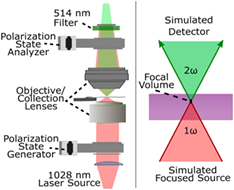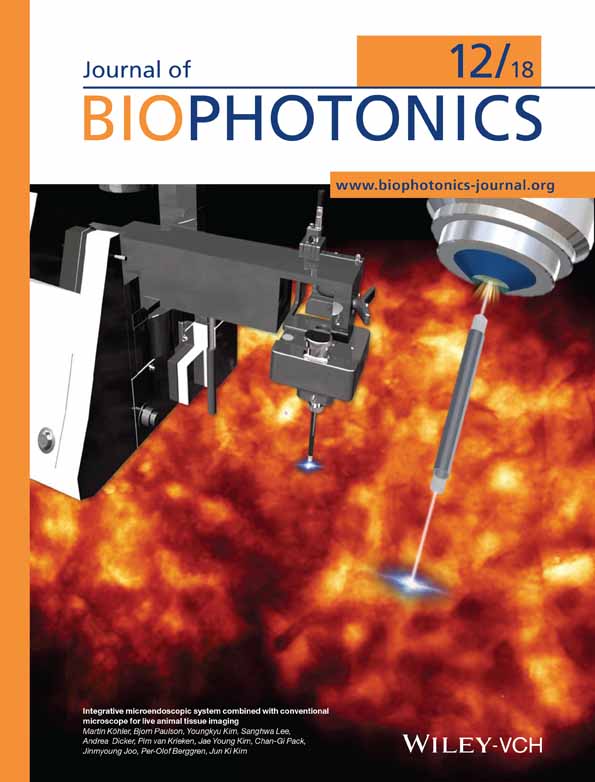Monte Carlo simulation of polarization-sensitive second-harmonic generation and propagation in biological tissue
Corresponding Author
K. L. Barry Fung
Division of Engineering Science, University of Toronto, Toronto, Ontario, Canada
Correspondence
K. L. Barry Fung, Division of Engineering Science, University of Toronto, 40 Saint George Street, Toronto, Ontario M5S 2E4, Canada.
Email: [email protected]
Search for more papers by this authorMasood Samim
Division of Biophysics and Bioimaging, Princess Margaret Cancer Centre, University Health Network, Toronto, Ontario, Canada
Search for more papers by this authorAdam Gribble
Department of Medical Biophysics, University of Toronto, Ontario, Canada
Search for more papers by this authorVirginijus Barzda
Department of Chemical and Physical Sciences, University of Toronto Mississauga, Mississauga, Ontario, Canada
Department of Physics, University of Toronto, Toronto, Ontario, Canada
Search for more papers by this authorI. Alex Vitkin
Division of Biophysics and Bioimaging, Princess Margaret Cancer Centre, University Health Network, Toronto, Ontario, Canada
Department of Medical Biophysics, University of Toronto, Ontario, Canada
Department of Radiation Oncology, University of Toronto, Toronto, Ontario, Canada
Search for more papers by this authorCorresponding Author
K. L. Barry Fung
Division of Engineering Science, University of Toronto, Toronto, Ontario, Canada
Correspondence
K. L. Barry Fung, Division of Engineering Science, University of Toronto, 40 Saint George Street, Toronto, Ontario M5S 2E4, Canada.
Email: [email protected]
Search for more papers by this authorMasood Samim
Division of Biophysics and Bioimaging, Princess Margaret Cancer Centre, University Health Network, Toronto, Ontario, Canada
Search for more papers by this authorAdam Gribble
Department of Medical Biophysics, University of Toronto, Ontario, Canada
Search for more papers by this authorVirginijus Barzda
Department of Chemical and Physical Sciences, University of Toronto Mississauga, Mississauga, Ontario, Canada
Department of Physics, University of Toronto, Toronto, Ontario, Canada
Search for more papers by this authorI. Alex Vitkin
Division of Biophysics and Bioimaging, Princess Margaret Cancer Centre, University Health Network, Toronto, Ontario, Canada
Department of Medical Biophysics, University of Toronto, Ontario, Canada
Department of Radiation Oncology, University of Toronto, Toronto, Ontario, Canada
Search for more papers by this authorAbstract
Polarization-sensitive second harmonic generation (p-SHG) is a nonlinear optical microscopy technique that has shown great promise in biomedicine, such as in detecting changes in the collagen ultrastructure of the tumor microenvironment. However, the complex nature of light-tissue interactions and the heterogeneity of biological samples pose challenges in creating an analytical and experimental quantification platform for tissue characterization via p-SHG. We present a Monte Carlo (MC) p-SHG simulation model based on double Stokes-Mueller polarimetry for the investigation of nonlinear light-tissue interaction. The MC model predictions are compared with experimental measurements of second-order nonlinear susceptibility component ratio and degree of polarization (DOP) in rat-tail collagen. The observed trends in the behavior of these parameters as a function of tissue thickness, as well as the overall extent of agreement between MC and experimental results, are discussed. High sensitivities of the susceptibility ratio and DOP are observed for the varying tissue thickness on the incoming fundamental light propagation pathway.

Supporting Information
| Filename | Description |
|---|---|
| jbio201800036-sup-0001-AppendixS1.docxWord document, 37 KB | Appendix S1 Supporting Information |
| jbio201800036-sup-0002-author-biographies.docxapplication/docx, 1.1 MB | Author Biographies |
Please note: The publisher is not responsible for the content or functionality of any supporting information supplied by the authors. Any queries (other than missing content) should be directed to the corresponding author for the article.
REFERENCES
- 1M. Samim, S. Krouglov, V. Barzda, J. Opt. Soc. Am. B 2015, 32, 451.
- 2F. S. Pavone, P. J. Campagnola, Second Harmonic Generation Imaging, CRC Press, Boca Raton 2016, p. 3.
- 3M. Strupler, A. M. Pena, M. Hernest, P. L. Tharaux, J. L. Martin, E. Beaurepaire, M. C. Schanne-Klein, Opt. Express 2007, 15, 4054.
- 4L. Moreaux, O. Sandre, J. Mertz, J. Opt. Soc. Am. B 2000, 17, 1685.
- 5S. W. Chu, S. Y. Chen, G. W. Chern, T. H. Tsai, Y. C. Chen, B. L. Lin, C. K. Sun, Biophys. J. 2004, 86, 3914.
- 6A. E. Tuer, S. Krouglov, N. Prent, R. Cisek, D. Sandkuijl, K. Yasufuku, B. C. Wilson, V. Barzda, J. Phys. Chem. B 2011, 115, 12769.
- 7A. E. Tuer, M. K. Akens, S. Krouglov, D. Sandkuijl, B. C. Wilson, C. M. Whyne, V. Barzda, Biophys. J. 2012, 103, 2093.
- 8N. Mazumder, C.-W. Hu, J. Qiu, M. R. Foreman, C. M. Romero, P. Török, F. J. Kao, Methods 2013, 66, 237.
- 9L. Kontenis, M. Samim, A. Karunendiran, S. Krouglov, B. Stewart, V. Barzda, Biomed. Opt. Express 2016, 7, 559.
- 10D. Tokarz, R. Cisek, A. Golaraei, S. L. Asa, V. Barzda, B. C. Wilson, Biomed. Opt. Express 2015, 6, 3475.
- 11A. Golaraei, R. Cisek, S. Krouglov, R. Navab, C. Niu, S. Sakashita, K. Yasufuku, M. S. Tsao, B. C. Wilson, V. Barzda, Biomed. Opt. Express 2014, 5, 3562.
- 12A. Golaraei, L. Kontenis, R. Cisek, D. Tokarz, S. J. Done, B. C. Wilson, V. Barzda, Biomed. Opt. Express 2016, 7, 4054.
- 13I. Gusachenko, M. C. Schanne-Klein, Phys. Rev. A 2013, 88, 053811-1.
- 14I. Gusachenko, G. Latour, M.-C. Schanne-Klein, Opt. Express 2010, 18, 19339.
- 15C. Zhu, Q. Liu, J. Biomed. Opt. 2013, 18, 50902.
- 16R. LaComb, O. Nadiarnykh, P. J. Campagnola, Biophys. J. 2008, 94, 4504.
- 17B. C. Wilson, G. Adam, Med. Phys. 1983, 10, 824.
- 18M. Friebel, A. Roggan, G. Müller, M. Meinke, J. Biomed. Opt. 2006, 11, 34021.
- 19O. Barajas, Å. M. Ballangrud, G. G. Miller, R. B. Moore, J. Tulip, Phys. Med. Biol. 1997, 42, 1675.
- 20S. Bartel, A. H. Hielscher, Appl. Optics 2000, 39, 1580.
- 21M. J. Raković, G. W. Kattawar, M. B. Mehrubeoğlu, B. D. Cameron, L. V. Wang, S. Rastegar, G. L. Coté, Appl. Optics 1999, 38, 3399.
- 22J. C. Ramella-Roman, S. A. Prahl, S. L. Jacques, Opt. Express 2005, 13, 4420.
- 23D. Côte, I. A. Vitkin, Opt. Express 2005, 13, 148.
- 24S. L. Jacques, L. Wang, Optical-Thermal Response of Laser-Irradiated Tissue, Vol. 47, Springer, Boston, MA 1995, p. 73.
10.1007/978-1-4757-6092-7_4 Google Scholar
- 25A. Major, R. Cisek, V. Barzda, Opt. Express 2006, 14, 12163.
- 26R. W. Boyd, Nonlinear Optics 3rd edittion, Academic Press, Burlington 2015, 38.
- 27M. Samim, S. Krouglov, D. F. James, V. Barzda, J. Opt. Soc. Am. B 2016, 33, 2617.
- 28Y. Shi, W. M. McClain, R. A. Harris, Phys. Rev. A 1994, 49, 1999.
- 29F. Jaillon, H. Saint-Jalmes, Appl. Optics 2003, 42, 3290.
- 30V. Periyasamy, M. Pramanik, J. Biomed. Opt. 2014, 19, 45003.
- 31L. L. Carter, E. D. Cashwell, Particle Transport Simulation with the Monte Carlo method, Office of Public Affairs, U.S. Energy Research and Development Administration, Technical Information Center, Oak Ridge, TN 1975.
10.2172/4167844 Google Scholar
- 32S. Alali, M. Ahmad, A. Kim, N. Vurgun, M. F. G. Wood, I. A. Vitkin, J. Biomed. Opt. 2012, 17, 45004.
- 33D. H. Goldstein, Polarized Light, CRC Press, Boca Raton, Florida, US, 2010.
10.1201/b10436 Google Scholar
- 34J. Rička, M. Frenz, in Optical-Thermal Response of Laser-Irradiated Tissue (Eds: A. J. Welch, M. J. C. Gemert), Springer Netherlands, Dordrecht 2011, p. 248.
- 35P. J. Campagnola, L. M. Loew, Nat. Biotechnol. 2003, 21, 1356.
- 36L. Barabesi, Statistica Applicata 1995, 7, 417.
- 37J. N. Gannaway, C. J. R. Sheppard, Opt. Quantum Electron. 1978, 10, 435.
- 38M. F. G. Wood, X. Guo, I. A. Vitkin, J. Biomed. Opt. 2007, 12, 14029.
- 39Y. Takano, M. Tanaka, Appl. Optics 1980, 19, 2781.
- 40J. Mertz, C. R. Acad. Sci. Ser. IV 2001, 2, 1153
- 41J. Mertz, L. Moreaux, Opt. Commun. 2001, 196, 325.
- 42M. F. G. Wood, N. Vurgun, M. A. Wallenburg, and I. A. Vitkin, Phys. Med. Biol., 2011, 56, N115.
- 43P. A. Bautista, Y. Yagi, J. Biomed. Opt. 2012, 17, 56013.
- 44V. V. Tuchin, in: Advances in Biophotonics (Eds: B.C. Wilson, V. V. Tuchin, and S. Tanev), IOS Press, Amsterdam, Netherlands 2000, pp. 85.
- 45D. J. Maitland, J. T. Walsh, Lasers Surg. Med. 1997, 20, 310.
10.1002/(SICI)1096-9101(1997)20:3<310::AID-LSM10>3.0.CO;2-H CAS PubMed Web of Science® Google Scholar
- 46A. N. Bashkatov, E. A. Genina, V. I. Kochubey, V. V. Tuchin, Proceedings of SPIE Volume 4162, Controlling Tissue Optical Properties: Applications in Clinical Study, SPIE, Amsterdam, the Netherlands 2000, p. 265.
- 47A. N. Bashkatov, E. A. Genina, V. I. Kochubey, V. V. Tuchin, J. Phys. D Appl. Phys. 2005, 38, 2543.
- 48S. van der Walt, S. C. Colbert, G. Varoquaux, Comput. Sci. Eng. 2011, 13, 22.
- 49J. D. Hunter, Comput. Sci. Eng. 2007, 9, 90.
- 50O. Nadiarnykh, P. J. Campagnola, Opt. Express 2009, 17, 5794.
- 51M. G. Monaghan, S. Kroll, S. Y. Brucker, K. Schenke-Layland, Tissue Eng. Part C Methods 2016, 22, 517.
- 52A. Tuer, D. Tokarz, N. Prent, R. Cisek, J. Alam, J. D. Dumont, L. Bakueva, J. Rowlands, V. Barzda, J. Biomed. Opt. 2010, 15, 26018.
- 53M. Samim, L. Kontenis, S. Krouglov, B. C. Wilson, V. Barzda, Opt. Life Sci. Congr. 2017 NTu3C.4. https://doi.org/10.1364/NTM.2017.NTu3C.4




